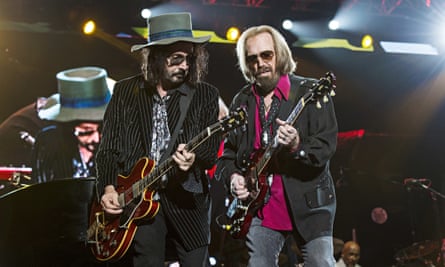In a chilling quote from much-loved music documentary The Last Waltz, about The Band’s final concert in 1976, leader Robbie Robertson looks straight into the camera and ominously says: ‘The road will kill you.”
At the time, he was just 34. Yet, over four decades later, musicians of his storied era are still on the road – and facing escalating health issues as a consequence. Since the start of this year, Ozzy Osbourne, 71, had to cancel his 2020 tour to seek treatment for issues related to his recent diagnosis of Parkinson’s disease. Elton John, 72, had to ditch dates on what was already advertised as his goodbye tour, after declaring himself “extremely unwell”. Madonna, 61, was forced to scratch a bunch of shows from her British tour due to “overwhelming pain” from injuries she sustained on the road which already caused her to nix some US dates. Meanwhile, Aerosmith felt compelled to disinvite drummer Joey Kramer from their Grammy performance, over alleged difficulties the 69-year-old was having keeping the beat, while the group itself has had to scratch dates due to various health issues experienced by Steven Tyler. Then, just this last week, the 56-year-old frontman of Metallica, James Hetfield, needed to cancel shows to, in his words, “look after my mental, physical and spiritual health”.
All this comes hot on the heels of an escalating wave of older stars who’ve either quit the road entirely or begun their last hurrahs, including Paul Simon at 78, Bob Seger at 74, Kiss aged between 68 to 70, Neil Diamond at 79, and Eric Clapton at 74.
“The fact is, it’s really hard to tour,” says Dave Brooks, who covers the concert industry for Billboard. “It’s terribly hard on your body, and mentally difficult too.”
Jem Aswad, senior music editor of the trade publication Variety, says: “People think it’s easy to be a rock star. But try to hold the attention of 18,000 people, and perform really well, for two and a half hours every night. It’s an incredibly tough thing to sustain.”

If all that wear-and-tear takes a toll on older performers, their increasing absence from the road threatens to weaken the concert industry’s bottom line. According to the industry’s most authoritative source, Pollstar, five out of the top 10 worldwide tours of the last year featured band members over the age of 50. Three of those were peopled with players aged 60 to nearly 80. In Pollstar’s list of top 200 North American tours, the top three earners were over 70, including Elton, Bob Seger and the Stones.
When it comes to the highest grossing single shows worldwide, four of the top five positions were occupied by a group with players over age 70, while 16 of the top 20 shows featured the same band. That would be the Rolling Stones, who are about to embark on yet another American jaunt this spring and summer, despite the fact that Mick Jagger had to have heart valve replacement surgery last April.
Small wonder Aswad calls older rock stars “the cornerstone of the concert industry”. He adds: “It’s a very real problem the industry is facing over the next ten years if more of them go out.”
Especially since the audience who attends shows by older stars has the deepest pockets, raising profits for everyone. “It’s a demographic that has some of the highest per capita income,” Brooks says. “If the rockers are ageing out, their customers are leaving the marketplace.”
And that has increasing consequence for the entire music business, given the paltry revenue generated by modern streaming compared to the hugely lucrative sales of old CDs. “For most artists, touring is the biggest revenue generator,” Brooks says.
In fact, the revenue the biggest bands create can rival the GDP of a small nation. Top stars can command an 80-20 – or in some cases, even a 95-5 – split of the funds from shows, with the lower portions going to the promoter. More, top artists can clean up at the merch table. “A lot of bands are selling beyond the T-shirt or a poster right now,” Brooks says. “Some of what’s sold is considered fashion and even vinyl collectables.”
Given such earning power, concerts play a powerful role in the economy overall. According to Brooks, the touring industry is generally estimated to generate between $50-60bn worldwide, aided by expanding markets in eastern Europe and Asia. Despite such daunting figures, the industry’s closest observers say they aren’t at all worried about the business’ ability to make up for the losses created by hobbled, or retired, oldsters. Ray Waddell, who has covered the concert business for over 30 years and who oversees Pollstar and Venues Now, says: “The industry has shown a remarkable ability to regenerate and replicate itself with new headliners, whether they be Billie Eilish, Ariana Grande or Ed Sheeran. Acts can break more quickly now, given the international accessibility of music and the new ways of discovering music.”
The changes don’t only reflect a new generation of fans but a switch in the popularity of genres. “Everybody tends to think about rock stars when they think about top touring acts,” says Aswad. “But pop is replacing it. We could very well be looking at a situation, 10 years from now, where the top touring acts will be Taylor Swift, Lady Gaga and Ed Sheeran.”
In fact, the single highest grossing tour worldwide for the last year, according to Pollstar, was by Pink, who is just 40. In a 12-month period, she sold over 1.8m tickets, yielding a gross of $215.2m, aided by a performance as prized for its death-defying acrobatics as its music. Doing strong business over the last year as well were twenty-something stars Shawn Mendes and Post-Malone, and the teen K-pop phenom, BTS, who were the sixth top grossing act in the world.

Even if the industry can keep thriving, however, there’s potential peril for those elders who keep trying to slog it out. In 2017, Tom Petty died days after finishing a tour at the age of 66, due to overuse of medications he was taking to deal with pain accrued from a lifetime on the road, including knee difficulties and a fractured hip. A year after his death, his wife, Dana, told Billboard: “He’d had it in his mind this was his last tour and he owed it to his long-time crew and his fans.”
The clear implication here is that Petty died, in part, because of a sense of duty to support the team around him, to his fans, and to the unspoken code of the road. Factors like these keep many artists on the road, even if they happen to have the personal wealth of Croesus, and they’re not, necessarily, in the best shape. In 2016, Prince died from overdosing on the prescription medicine he was given to deal with pain caused by years of leaping around the stage in high heels. Given stories like these, Robbie Robertson’s quote seems not just cautionary, but prophetic.
At the same time, many of the old war horses have proven themselves incredibly hearty, as well as eager. “These artists live to perform,” Waddell says. “You can sell, or download, millions of records, but that’s no substitute for 20,000 people loving every move you make. Very few people get to experience anything that powerful.”
